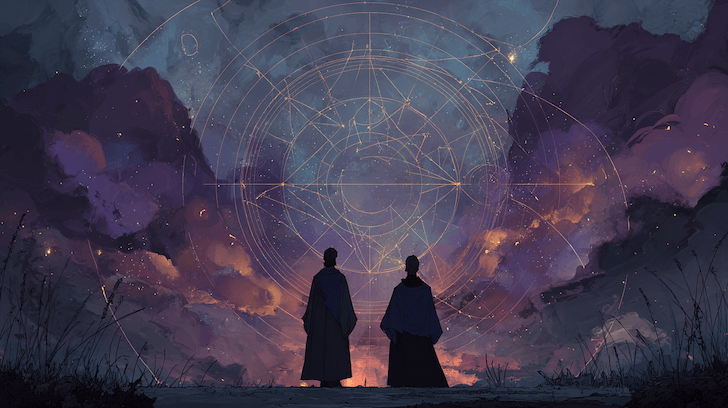Asteroids in Astrology

Asteroids add depth to astrology. They don’t rewrite your chart’s main story but bring it into finer focus—how you nurture, problem-solve, commit, focus, and heal. They show the quieter, human-scale details that give planetary themes their emotional tone.
Think of asteroids as nuance. The planets describe what happens; asteroids describe how it feels and how it plays out in ordinary life.
Asteroids 101
Asteroids are small bodies that orbit the Sun, mostly between Mars and Jupiter in what’s called the asteroid belt. Discovered in the 19th century, they were named after deities and mythic figures whose stories give them symbolic meaning.
Because there are hundreds of thousands of them, astrologers focus on a select few that consistently show psychological and symbolic weight. The first four discovered—Ceres, Pallas Athena, Juno, and Vesta—along with Chiron, form the backbone of asteroid interpretation.
Major Asteroids
These five asteroids each describe a fundamental theme of human experience. The table below gives a quick orientation before diving deeper.
| Asteroid | Discovered | Core Meaning |
|---|---|---|
| Ceres | 1801 | Nurturing, care, and emotional nourishment |
| Pallas Athena | 1802 | Wisdom, pattern recognition, and creative strategy |
| Juno | 1804 | Partnership, loyalty, and fairness in relationships |
| Vesta | 1807 | Devotion, focus, and sacred work |
| Chiron | 1977 | Healing, mentorship, and wisdom through pain |
Ceres represents the instinct to nourish and protect life. It shows how we give comfort, how we recover from loss, and what makes us feel emotionally safe.
Ceres placements often describe one’s relationship with food, the body, family care, or the natural cycles of giving and receiving. A strong Ceres can appear in the charts of healers, cooks, parents, or anyone whose life centers on tending and renewal.
Its mythology—Demeter’s loss and reunion with her daughter Persephone—mirrors emotional cycles we all experience: attachment, loss, and eventual reconciliation. In a chart, that story becomes personal, describing how we let go, grieve, and begin again.
Pallas Athena symbolizes strategic intelligence—the ability to see design and order in chaos. She blends logic and creativity, turning insight into craft, artistry, or diplomacy.
In astrology, Pallas shows how we solve problems and apply wisdom. It’s active in charts of artists, thinkers, and healers who use pattern recognition and intuition to guide their work.
Her mythology—born from Zeus’s head, fully formed—captures that sense of mental clarity. Pallas reveals how intellect and vision combine, often showing how a person refines skill into mastery or uses understanding as protection.
Juno speaks to commitment, equality, and trust within relationships. She governs how we bond over time, what we expect in partnership, and what makes us feel respected.
A strong Juno placement can mark someone who seeks deep loyalty or struggles when balance and fairness are missing. It can describe both romantic devotion and business or creative partnerships that rely on mutual respect.
Juno’s mythology as the goddess of marriage reminds us that commitment isn’t just emotional—it’s also ethical. In a chart, she reflects how promises are kept, how power is shared, and how love becomes responsibility.
Vesta represents devotion, focus, and the sacred use of energy. She governs where we pour effort wholeheartedly, and what must stay pure to keep the flame alive.
In mythology, Vesta tended the eternal fire of Rome. In astrology, her placement shows the part of life that requires solitude, ritual, or consistent dedication.
When Vesta is strong, there’s often a calling toward service, craft, or spiritual maintenance—a need to protect time and focus for what feels sacred. At its best, Vesta teaches the balance between work and renewal, between keeping the flame and letting it rest.
Chiron is the bridge between pain and purpose. Known as the “wounded healer,” it represents the kind of suffering that leads to understanding and compassion.
It doesn’t describe weakness—it describes transformation. Where Chiron sits in the chart shows an area that feels tender but also holds the key to wisdom. It’s where we teach best because we’ve learned the hardest.
When linked to the Sun, Moon, or Ascendant, Chiron often marks a life path of mentoring, therapy, or healing through empathy. Its gift is turning personal struggle into guidance for others.
Additional Asteroids
Beyond these five, there are hundreds more. Most astrologers only use them when they echo existing chart themes. A few well-known examples include:
- Eros: Passion, attraction, and creative spark.
- Psyche: Sensitivity, soul connection, and intuition.
- Hygiea: Health, cleanliness, and preventive care.
- Astraea: Justice, service, and persistence.
- Sappho: Friendship, art, and poetic expression.
- Amor: Unconditional love and compassion.
- Urania: Astrology, astronomy, and higher understanding.
These smaller bodies can add refinement and specificity, but they work best when their symbolism repeats something already emphasized in the chart—never as standalone influences.
Why They Matter
Asteroids make astrology more human. They fill in the emotional and creative subtleties between the planets, translating cosmic patterns into everyday experience. They describe how love becomes care, how focus becomes purpose, and how pain becomes wisdom—reminding us that even the smallest bodies in the solar system can hold meaning.
Aspects in Astrology

Get Your Birth Chart
Calculate your complete astrological chart with precise astronomical data based on your birth time and location
Generate Chart